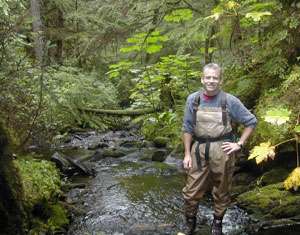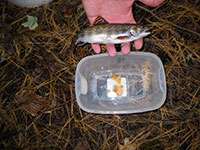Research reveals migrating Great Lakes salmon carry contaminants upstream

(Phys.org)—Be careful what you eat, says University of Notre Dame stream ecologist Gary Lamberti.
If you're catching and eating fish from a Lake Michigan tributary with a strong salmon run, the stream fish—brook trout, brown trout, panfish—may be contaminated by pollutants carried in by the salmon.
Research by Lamberti, professor and chair of biology, and his laboratory has revealed that salmon, as they travel upstream to spawn and die, carry industrial pollutants into Great Lakes streams and tributaries. The research was recently published in the journal Environmental Science and Technology.
It's a problem inadvertently created by people with good intentions, he notes.
"Most people don't realize that salmon are a non-native species in the Great Lakes," he says. "They were introduced to control alewives—another non-native fish species."
Although salmon fed on and contained the alewives—and have become important to sport fishing—there were unintended consequences. That's because of a lengthy history of industrial pollution of the Great Lakes.
"All the Great Lakes have some level of pollution," says Lamberti, "especially near cities—Chicago, Detroit, Cleveland. There are far fewer pollutants now than over the past century, but many are persistent. There are hot spots, and Lake Michigan has a lot of them—heavy metals, mercury, organic pollutants like PCBs."
PCBs (polychlorinated biphenyls) come from fluids in older electrical transformers. Also present is DDE (dichlorodiphenyldichloroethylene), a breakdown product of the banned insecticide DDT, and PBDEs (polybrominated diphenyl ethers). PBDEs, notes Lamberti, are flame retardants used in furniture, mattresses and children's clothing. "They wash out when you do the laundry."

Even intentionally introduced species such as the Pacific salmon can result in unintended consequences for the ecosystem and the environment.
Salmon acquire pollutants through the lake food chain. When they are young, they feed on invertebrates—worms and insect larvae. As they grow larger, salmon consume more and more fish, such as alewives—which have also picked up pollutants through invertebrates they eat, which have picked up pollutants from algae and bacteria.
Salmon are a fatty fish, and these polluting chemicals are particularly "sticky," Lamberti says. "They are lipophilic—they absorb into fat tissue."
The consequence is that the salmon magnify the pollutants as they move up the food chain. "Salmon are longer lived, eat more, and the pollutants are then bio-concentrated."
The concern is that salmon are naturalized to many tributaries of the Great Lakes. "And it's a one-way street for them," Lamberti says. "They spawn, die in the stream where they spawn, and then leave their contaminant load in the stream. Stream fish eat salmon eggs, and may also eat carcass tissue as they decompose."
Fish in streams and tributaries with large salmon runs—fish that never go out into the lake, he notes—show contaminant levels very similar to that of Great Lakes salmon.
"Let's keep in mind," he adds, "there are FDA advisories for pregnant women and children on the risks of eating large Great Lakes fish, because of the danger of chemical contaminants.
"But there are no warnings for stream fish—that's the specter. If you're eating fish from a stream with a lot of salmon, you might as well be eating the salmon. I would err on the side of caution when eating any fish from a salmon river. Either that or harvest fish only upstream of where salmon spawn."
For comparison purposes, Lamberti's research analyzed the tissue of fish upstream from where salmon spawn and die.
"The upstream section of the same river was not contaminated. Below the salmon, the river had measurable levels of contaminants. There's no other way for the contaminants to get there but the salmon. Water doesn't flow uphill."
The conclusion?
Although salmon are an economic benefit to the Great Lakes and perform important ecological functions (such as controlling the population of alewives), we need to consider the impact of salmon on streams where they spawn.
"If we want to remove a dam on a river—and that will allow salmon to move upstream—we need to realize that the salmon will carry pollutants with them and disperse them into the food web," Lamberti says.
"In sensitive areas with a lot of native fish, we might want to prevent salmon from moving upstream. And in the Great Lakes, maybe we should consider restoring the native populations of lake trout and whitefish rather than encouraging more salmon."
More information: pubs.acs.org/doi/abs/10.1021/es301864k
Journal information: Environmental Science and Technology
Provided by University of Notre Dame














